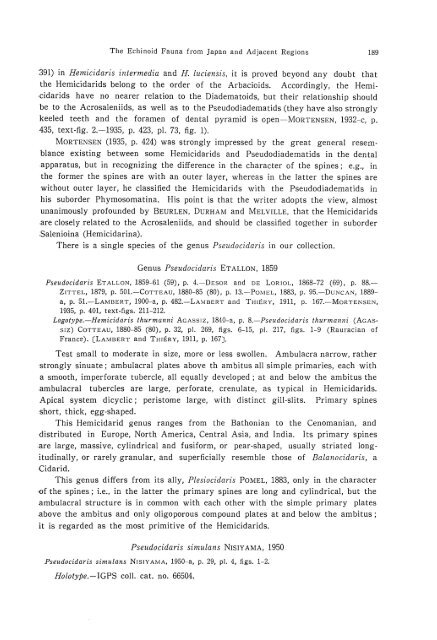the echinoid fauna from japan and adjacent regions part i
the echinoid fauna from japan and adjacent regions part i
the echinoid fauna from japan and adjacent regions part i
You also want an ePaper? Increase the reach of your titles
YUMPU automatically turns print PDFs into web optimized ePapers that Google loves.
The Echinoid Fauna <strong>from</strong> Japan <strong>and</strong> Adjacent Regions 189<br />
391) in Hemicidaris intermedia <strong>and</strong> H. luciensis, it is proved beyond any doubt that<br />
<strong>the</strong> Hemicidarids belong to <strong>the</strong> order of <strong>the</strong> Arbacioids. Accordingly, <strong>the</strong> Hemicidarids<br />
have no nearer relation to <strong>the</strong> Diadematoids, but <strong>the</strong>ir relationship should<br />
be to <strong>the</strong> Acrosaleniids, as well as to <strong>the</strong> Pseudodiadematids (<strong>the</strong>y have also strongly<br />
keeled teeth <strong>and</strong> <strong>the</strong> foramen of dental pyramid is open-MORTENSEN, 1932-c, p.<br />
435, text-fig. 2.-1935, p. 423, pI. 73, fig. 1).<br />
MORTENSEN (1935, p. 424) was strongly impressed by <strong>the</strong> great general resemblance<br />
existing between some Hemicidarids <strong>and</strong> Pseudodiadematids in <strong>the</strong> dental<br />
apparatus, but in recognizing <strong>the</strong> difference in <strong>the</strong> character of <strong>the</strong> spines; e.g., in<br />
<strong>the</strong> former <strong>the</strong> spines are with an outer layer, whereas in <strong>the</strong> latter <strong>the</strong> spines are<br />
without outer layer, he classified <strong>the</strong> Hemicidarids with <strong>the</strong> Pseudodiadematids in<br />
his suborder Phymosomatina. His point is that <strong>the</strong> writer adopts <strong>the</strong> view, almost<br />
unanimously profounded by BEURLEN, DURHAM <strong>and</strong> MELVILLE, that <strong>the</strong> Hemicidarids<br />
are closely related to <strong>the</strong> Acrosaleniids, <strong>and</strong> should be classified toge<strong>the</strong>r in suborder<br />
Salenioina (Hemicidarina).<br />
There is a single species of <strong>the</strong> genus Pseudocidaris in our collection.<br />
Genus Pseudocidaris ETALLON, 1859<br />
Pseudocidaris ETALLON, 1859-61 (59), p. 4.-DESOR <strong>and</strong> DE LORIOL, 1868-72 (69), p. 88.<br />
ZITTEL, 1879, p. 501.-COTTEAU, 1880-85 (80), p. 13.-PoMEL, 1883, p. 95.-DuNCAN, 1889a,<br />
p. 51.-LAMBERT, 1900-a, p. 482.-LA:VIBERT <strong>and</strong> THIBRY, 1911, p. 167.-MoRTENsEN,<br />
1935, p. 401, text-figs. 211-212.<br />
Logotype.-Hemicidaris thurmanni AGASSIZ, 1840-a, p. 8.-Pseudocidaris thurmanlli (AGAS<br />
SIZ) COTTEAU, 1880-85 (80), p. 32, pI. 269, figs. 6-15, pI. 217, figs. 1-9 (Rauracian of<br />
France). [LAMBERT <strong>and</strong> THIERY, 1911, p. 167J.<br />
Test small to moderate in size, more or less swollen. Ambulacra narrow, ra<strong>the</strong>r<br />
'strongly sinuate; ambulacral plates above th ambitus all simple primaries, each with<br />
a smooth, imperforate tubercle, all equally developed; at <strong>and</strong> below <strong>the</strong> ambitus <strong>the</strong><br />
ambulacral tubercles are large, perforate, crenulate, as typical in Hemicidarids.<br />
Apical system dicyclic; peristome large, with distinct gill-slits. Primary spines<br />
short, thick, egg-shaped.<br />
This Hemicidarid genus ranges <strong>from</strong> <strong>the</strong> Bathonian to <strong>the</strong> Cenomanian, <strong>and</strong><br />
distributed in Europe, North America, Central Asia, <strong>and</strong> India. Its primary spines<br />
are large, massive, cylindrical <strong>and</strong> fusiform, or pear-shaped, usually striated longitudinally,<br />
or rarely granular, <strong>and</strong> superficially resemble those of Balanocidaris, a<br />
Cidarid.<br />
This genus differs <strong>from</strong> its ally, Plesiocidaris POMEL, 1883, only in <strong>the</strong> character<br />
-of <strong>the</strong> spines; i.e., in <strong>the</strong> latter <strong>the</strong> primary spines are long <strong>and</strong> cylindrical, but <strong>the</strong><br />
ambulacral structure is in common with each o<strong>the</strong>r with <strong>the</strong> simple primary plates<br />
above <strong>the</strong> ambitus <strong>and</strong> only oligo porous compound plates at <strong>and</strong> below <strong>the</strong> ambitus;<br />
it is regarded as <strong>the</strong> most primitive of <strong>the</strong> Hemicidarids.<br />
Pseudocidaris simulans NISIY AMA, 1950<br />
Pseudocidaris simulans NISIY AMA, 1950-a, p. 29, pI. 4, figs. 1-2.<br />
Holotype.-IGPS colI. cat. no. 66504.












